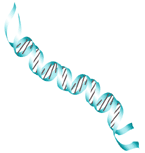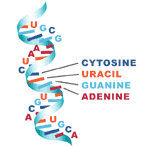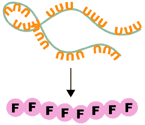 |
The DNA molecule, the carrier of the genetic information. |
In 1953 James Watson and Francis Crick revealed the structure and properties of DNA, the molecule that carries our genetic information. What they discovered was that the blueprint for a human being was encapsulated in a long string of nucleic acid, arranged in a double helix, like a twisted rope ladder with three billion rungs. For this discovery Watson and Crick, together with Maurice Wilkins, were awarded the Nobel Prize in Physiology or Medicine in 1962.
But one big question remained unanswered: how is the information in the DNA strand translated to protein? Among many others, three scientists, Marshall Warren Nirenberg, Har Gobind Khorana and Robert William Holley, set their minds on understanding how the four-letter code of DNA could be translated into the 20-letter alphabet of amino acids, the building blocks that make up proteins.
Genetic information is located in the nucleus of a cell. It is carried from one generation to the next through the linear sequence of nucleotides that make up each of the strands of the DNA helix. These consist of the four nucleotides adenine, thymine, cytosine and guanine, abbreviated A, T, C and G. The two DNA strands are paired in a restricted way: G and C can bind only to each other, and the same goes for A and T.
When the information is needed to make a protein, it is first translated to another kind of nucleic acid, called RNA. RNA is composed much like DNA, but it is single-stranded. Also, when the strand of DNA letters is translated to RNA, the T is exchanged for an U (uracil). This RNA is called messenger RNA (or mRNA).
 |
RNA, a molecule which resembles DNA, is however single-stranded. |
The strand of letters making up the messenger RNA is then translated to protein in a complex set of reactions that occur in a structure called a ribosome. First, the amino acids used for making protein are attached to another kind of RNA, so-called transfer RNA, or tRNA. This family of clover-leaf shaped molecules has the capacity to read the genetic code and transform it into the protein alphabet. Each tRNA binds only to one kind of amino acid, and each tRNA recognizes a particular set of three nucleotides in the mRNA strand: triplets that correspond to a particular amino acid. The protein molecule is then built by adding one amino acid at a time, using the mRNA as a template.
When the structure of DNA was made known, many scientists were eager to read the message hidden in it. One was the Russian physicist George Gamow. Many researchers are ”lone rangers” but Gamow believed that the best way to move forward was through a joint effort, where scientists from different fields shared their ideas and results. In 1954, he founded the "RNA Tie Club." Its aim was "to solve the riddle of the RNA structure and to understand how it built proteins."
 |
George Gamow, Russian physicist, founded the "RNA Tie Club" in 1954. |
The brotherhood consisted of 20 regular members (one for each amino-acid), and four honorary members (one for each nucleotide in nucleic acid). The members all got woolen neckties, with an embroided green-and-yellow helix (idea and design by Gamow).
Among the members were many prominent scientists, eight of whom were or became Nobel Laureates. Such examples are James Watson, who in the club received the code PRO for the amino acid proline, Francis Crick (TYR for tyrosine) and Sydney Brenner (VAL for valine). Brenner was awarded the Nobel Prize in Physiology or Medicine as recently as 2002, for his discoveries concerning genetic regulation of organ development and programmed cell death.
The members of the club met twice a year, and in the meantime they wrote each other letters where they put forward speculative new ideas, which were not yet ripe enough to be published in scientific journals.
In 1955 Francis Crick proposed his "Adapter Hypothesis," which suggested that some (so far unknown) structure carried the amino acids and put them in the order corresponding to the sequence in the nucleic acid strand.
Gamow, on the other hand, used mathematics to establish the number of nucleotides that should be necessary to make up the code for one amino acid. He postulated that a three-letter nucleotide code would be enough to define all 20 amino acids.
But it was a non-member of the club who actually deciphered the first letter of the code, a finding that stunned the scientific community when the result was presented at a biochemistry conference in Moscow in 1961.
At the time when the members of the "RNA Tie Club" were trying to decipher the code, Marshall W. Nirenberg was also at work in his laboratory at the National Institutes of Health, outside Washington D.C.
 |
Marshall Nirenberg, the scientist that deciphered the genetic code in 1961. |
Together with his colleague Johann H. Matthaei, he tried to figure out how the genetic information hidden in the DNA strand could eventually be read out as protein. They used a so-called "cell-free" system: in a test tube they put together all the things they thought were needed for protein synthesis – RNA template, ribosomes, nucleotides, amino acids, stabilizing agents and energy.
They carried out a series of experiments to see what amino acid a particular nucleotide template gave rise to. Strands of template with a known combination of nucleotides were run in the "cell-free" system.
They made a very simple nucleic acid, composed of a chain of only one single, repeated letter – the nucleotide uracil, or U. Using this nucleic acid, the system produced a protein that also contained a single letter, but now written in the protein language: the amino acid F, phenylalanine. By showing that a strand of U triplets was indeed the template for the amino acid phenylalanine they cracked the first letter of the code.
This was the result Nirenberg presented in Moscow. While he was at the conference he got a phone call from Matthaei (still working at the lab back home) who told him that CCC was probably the template for the amino acid proline, P.
 |
The experiment which used uracil (U) as a template produced a protein entirely made up of the amino acid phenylalanine (F). The first letter of the genetic code was hence identified. |
Har Gobind Khorana, at the University of Wisconsin, devised precise and intricate biochemical methods to produce well-defined nucleic acids, long strands of RNA with every nucleotide in exact position. The first one he made was a strand repeating the two nucleotides UCUCUC. This translated into a strand of amino acids, reading serine-leucine-serine-leucine... Synthetic RNA were later used to decipher the rest of the genetic code.
Robert Holley was a chemist at Cornell University, but learned about protein synthesis during a sabbatical year at Caltech in California. He discovered the special type of nucleic acid called transfer RNA, or tRNA for short.
In 1965 Holley was able to work out its exact structure. This was the first time anyone had established the complete chemical structure of a nucleic acid that was biologically active. tRNA turned out to be the missing molecule that Crick had proposed in his ”Adapter Hypothesis” ten years earlier.
In 1968, seven years after the first letter of the code was presented in Moscow, Nirenberg, Khorana and Holley were awarded the Nobel Prize in Physiology or Medicine.
 |
 |
 |
| Har Gobind Khorana, creator of new methods to produce synthetic nucleic acids. | Robert Holley, the discoverer of the transfer RNA - tRNA. | E. coli bacteria, widely used in molecular biology research. |
The importance of the research that was awarded the Nobel Prize in Physiology or Medicine in 1968 cannot be overestimated. Cracking the code of life paved the way for a tremendous boom in molecular biology, enabling scientists to put together strings of DNA and RNA to produce selected proteins.
One example where this technique is used is in the production of pharmaceuticals. The DNA that encodes the protein you want is synthesized and put in bacteria. A new copy of the desired protein is produced every time the bacterium divides. Since an E. coli bacteria can produce approximately 17 million daughter cells during an 8-hour working day (and bacteria work 24 hours a day, 7 days a week), the production is very efficient. In this fashion it is now possible to make many useful proteins, for example insuline (to treat diabetic patients) and different coagulation factors that are needed by patients suffering from hemophilia.
By Lotta Fredholm, Science Journalist
First published 7 July 2004
| READ MORE | MORE ABOUT DNA - THE DOUBLE HELIX | |||||||||||
|
|
|||||||||||
| MORE ABOUT DNA-RNA-PROTEIN | MORE ABOUT MARSHALL NIRENBERG | |||||||||||
|
|
|||||||||||
printFooter(); ?>